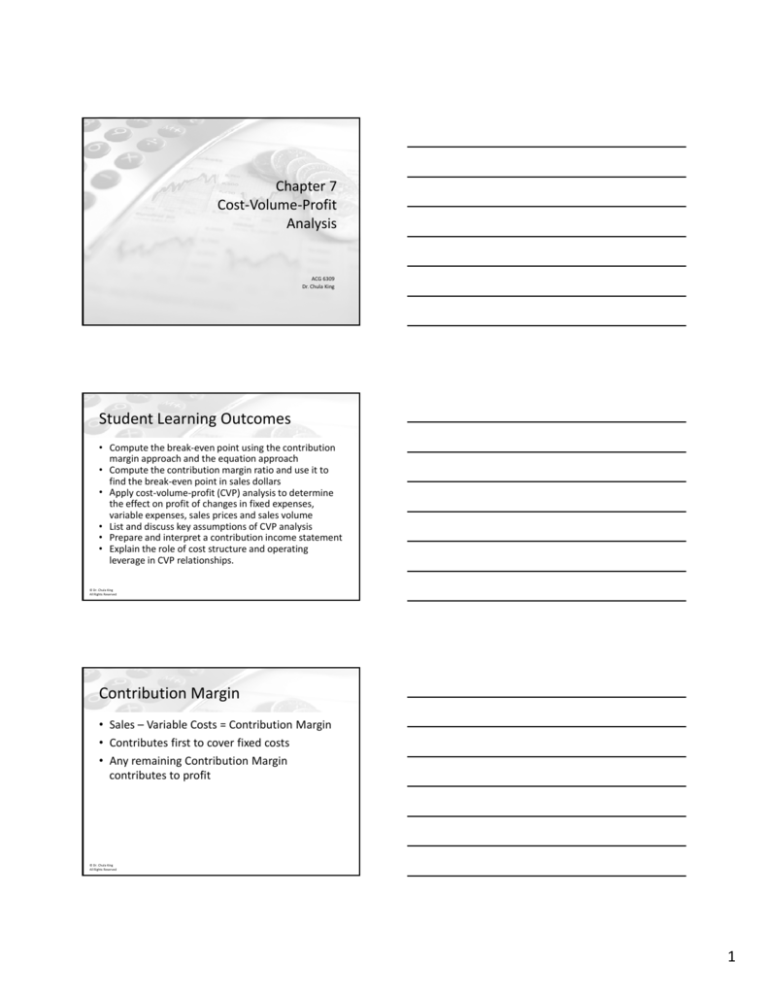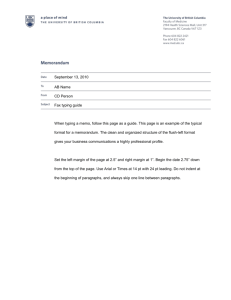
Chapter 7
Cost‐Volume‐Profit Analysis
ACG 6309
Dr. Chula King
© Dr. Chula King
All Rights Reserved
Student Learning Outcomes
• Compute the break‐even point using the contribution margin approach and the equation approach
• Compute the contribution margin ratio and use it to find the break‐even point in sales dollars
• Apply cost‐volume‐profit (CVP) analysis to determine pp y
p
(
)
y
the effect on profit of changes in fixed expenses, variable expenses, sales prices and sales volume
• List and discuss key assumptions of CVP analysis
• Prepare and interpret a contribution income statement • Explain the role of cost structure and operating leverage in CVP relationships.
© Dr. Chula King
All Rights Reserved
Contribution Margin
• Sales – Variable Costs = Contribution Margin
• Contributes first to cover fixed costs
• Any remaining Contribution Margin contributes to profit
ib
fi
© Dr. Chula King
All Rights Reserved
1
For Example
Alpine, Inc., manufactures and sells baskets that sell for $20 each. The variable cost per basket is $8, and fixed costs total $120,000. The current sales volume is 18,000 baskets. What is Alpine’s contribution margin in total, and on a unit basis?
Sales (18,000 x $20)
$360,000
Less Variable costs (18,000 x $8)
(144,000)
Contribution margin
$216,000
Less Fixed costs
(120,000)
Net income
$ 96,000
Contribution margin/unit = $20 ‐ $8 = $12
© Dr. Chula King
All Rights Reserved
Break‐Even Point
• Point at which revenues equal expenses
• Contribution margin approach:
– First, compute the contribution margin/unit = Sales price/unit –
Sales price/unit Variable cost/unit
Variable cost/unit
– Then, compute the break‐even point = Total fixed costs ÷ Contribution margin/unit
• Continuing the example:
Break‐even point = $120,000 ÷ $12/unit = 10,000 units
© Dr. Chula King
All Rights Reserved
What This Means
• If Alpine sells 10,000 baskets:
Sales (10,000 x $20)
$200,000
Variable costs (10,000 x $8)
(80,000)
Fixed Costs
(120,000)
Net income
$
0
© Dr. Chula King
All Rights Reserved
2
What This Means
• At the break‐even point, all costs are covered, and the net income is $0.
• For each unit sold above the break‐even point, the profit added is equal to the contribution the profit added is equal to the contribution
margin.
• Sales of 18,000 exceed the break‐even point by 8,000 units (18,000 – 10,000)
• 8,000 units x $12/unit = $96,000!
© Dr. Chula King
All Rights Reserved
Equation Approach
• Let X = Sales volume at which the profit will be zero
• (Sales price/unit x X) – (Variable cost/unit x X)–
X) Fixed expenses = $0
Fixed expenses = $0
• Continuing the example:
$20X ‐ $8X ‐ $120,000 = $0 $12X = $120,000
X = $120,000 ÷ $12 = 10,000 units
© Dr. Chula King
All Rights Reserved
Contribution Margin (CM) Ratio
• Contribution Margin ÷ Sales = CM Ratio
• Break‐even point in sales dollars = Total fixed costs ÷ CM Ratio
• Continuing the example: Contribution Margin = i i
h
l
ib i
i
$216,000; Sales = $360,000; Fixed costs = $120,000
• CM Ratio = $216,000 ÷ $360,000 = 60%
• Break‐even point = $120,000 ÷ 60% = $200,000
© Dr. Chula King
All Rights Reserved
3
Target Net Profit (CM Approach)
• (Fixed costs + Target profit) ÷ Contribution margin/unit = # units to be sold to earn target profit.
• Assume that Alpine wants to achieve a target Assume that Alpine wants to achieve a target
net profit of $150,000. How many baskets must be sold?
• ($120,000 + $150,000) ÷ $12/basket = 22,500 baskets
© Dr. Chula King
All Rights Reserved
Target Net Profit (Equation Approach)
• Let X = number of units to achieve the target net profit
• (Sales price x X) – (Variable cost/unit x X) –
Fixed cost = Target net profit
Fixed cost = Target net profit
• Continuing the example:
• $20X ‐ $8X ‐ $120,000 = $150,000
• $12X = $270,000
• X = $270,000 ÷ $12 = 22,500 baskets
© Dr. Chula King
All Rights Reserved
Applying Cost‐Volume‐Profit Analysis
• Safety Margin
• Changes in Contribution Margin (Sales price and/or variable costs)
• Changes in Fixed Costs
h
i i d
© Dr. Chula King
All Rights Reserved
4
Safety Margin
• Difference between budgeted sales revenue and break‐even sales revenue
• The amount by which sales can drop before losses begin to be incurred.
losses begin to be incurred
• Continuing the example, if the 18,000 baskets sold were the budgeted amount at $20/basket
• Safety margin = (18,000 – 10,000) = 8,000 baskets x $20/basket = $160,000
© Dr. Chula King
All Rights Reserved
Changes in Unit Contribution
• Change in sales price
• Increase in sales price will increase contribution margin and lower break‐even point
• Decrease in sales price will decrease contribution margin and increase break‐even point
• Is the change desirable?
© Dr. Chula King
All Rights Reserved
Changes in Fixed Costs
• Suppose that Alpine wanted to increase its advertising budget by $36,000 in hopes that sales would increase from 18,000 baskets to 20,000 baskets. Should this be done?
• Additional fixed cost ÷
Additional fixed cost ÷ Contribution margin = $36,000 ÷
Contribution margin = $36 000 ÷
$12 = 3,000 units
• In order to break‐even with the additional fixed cost, Alpine would have to sell 3,000 additional baskets. If the increased advertising would only generate an additional 2,000 baskets, Alpine would not be able to fully cover the additional cost. Its profit would be reduced by $12,000 (1,000 units x $12)
© Dr. Chula King
All Rights Reserved
5
Changes in Fixed Cost
Sales @$20/basket
Less Variable costs @ Less Variable costs @
$8/basket
Contribution Margin
Less Fixed costs
Net income
Current Sales Proposed Sales 18,000 Baskets 20,000 Baskets
$360,000
$400,000
144,000
$216,000
120,000
$96,000
160,000
$240,000
156,000
$84,000
$12,000 Profit Reduction
© Dr. Chula King
All Rights Reserved
Multiple Products
• Sales mix – relative combination in which a company’s products are sold
• Different products have different selling p
prices, cost structures and contribution ,
margins
• Assume that Alpine sells both baskets and picture frames
• The picture frames have a unit selling price of $30, and a unit variable cost of $20
© Dr. Chula King
All Rights Reserved
Multiple Products
Selling Price
Unit Variable Cost
Unit Contribution Margin
Number of items Sold
Baskets
$20
$8
$12
18,000
60%
Picture frames
$30
$20
$10
12,000
40%
Item
Total
% of Total
30 000
30,000
Weighted Average Unit Contribution Margin
Item
Unit Contribution Margin
x
% of Total
Weighted Contribution
Baskets
$12
x
60%
7.20
Picture frames
$10
x
40%
4.00
Total
11.20
© Dr. Chula King
All Rights Reserved
6
Break‐Even Point with Multiple Products
• Total fixed cost = $120,000
• Weighted‐average contribution margin = $11.20
• Break‐even point = $120,000 ÷
k
i
$ 20 000 11.20 = 10,714 20 0
combined units
• Baskets: 60% x 10,714 = 6,428
• Picture Frames: 40% x 10,714 = 4,286
© Dr. Chula King
All Rights Reserved
Assumptions
• Selling price is constant throughout the entire relevant range
• Costs are linear over the relevant range
• In a multi‐product company, the sales mix is li
d
h
l
i i
constant
• In manufacturing firms, inventories do not change
© Dr. Chula King
All Rights Reserved
Income Statements
Traditional Format
Contribution Margin Format
Name of Company
Income Statement
For the Year ended xxx
Sales
Less: Cost of Goods Sold
Gross Margin
Less: Operating Expense
Net Income
Name of Company
Income Statement
For the Year ended xxx
Sales
Less Variable Costs
Contribution Margin
Less Fixed Costs
Net Income
© Dr. Chula King
All Rights Reserved
7
Cost Structure and Operating Leverage
• Cost structure: Relative proportion of fixed and variable costs
• Operating leverage
– Extent to which an organization uses fixed costs in E t t t hi h
i ti
fi d
t i
its cost structure
– It is a measure at a given level of sales, of how a percent change in sales volume will affect profits
– Greatest in companies that have a high proportion of fixed costs in relation to variable costs
– Formula: Contribution margin ÷ Net income
© Dr. Chula King
All Rights Reserved
Returning to Alpine Example
Sales (18,000 x $20)
$360,000
Less Variable costs (18,000 x $8) (144,000)
Contribution margin
$216,000
Less Fixed costs
(120,000)
Net income
$ 96,000
Operating leverage = $216,000 ÷ $96,000 = 2.25
This means that a 10% increase in sales will increase profits 22.5% (10% x 2.25)
© Dr. Chula King
All Rights Reserved
Concluding Comments
• Compute the break‐even point using the contribution margin approach and the equation approach
• Compute the contribution margin ratio and use it to find the break‐even point in sales dollars
• Apply cost‐volume‐profit (CVP) analysis to determine pp y
p
(
)
y
the effect on profit of changes in fixed expenses, variable expenses, sales prices and sales volume
• List and discuss key assumptions of CVP analysis
• Prepare and interpret a contribution income statement • Explain the role of cost structure and operating leverage in CVP relationships. © Dr. Chula King
All Rights Reserved
8
The Next Step
• Exercises 7‐24, 7‐25, 7‐28, 7‐29
• Problems 7‐36, 7‐37, 7‐39, 7‐44
© Dr. Chula King
All Rights Reserved
9









